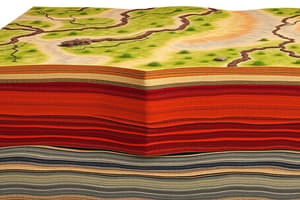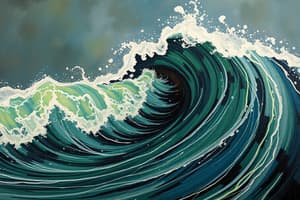Podcast
Questions and Answers
What type of wave travels through all three states of matter?
What type of wave travels through all three states of matter?
- Rayleigh Wave
- S Wave
- P Wave (correct)
- Love Wave
Which of the following is true about Secondary waves (S Waves)?
Which of the following is true about Secondary waves (S Waves)?
- They move parallel to the direction of motion.
- They can travel through both liquid and solid matter.
- They are the fastest seismic waves.
- They arrive after Primary waves. (correct)
Which seismic wave type has both perpendicular and parallel movement?
Which seismic wave type has both perpendicular and parallel movement?
- Rayleigh Wave (correct)
- S Wave
- Love Wave
- P Wave
What is the primary responsibility of a seismologist?
What is the primary responsibility of a seismologist?
What technique is used to determine the location of an earthquake's epicenter?
What technique is used to determine the location of an earthquake's epicenter?
What feature is considered the initial point of an earthquake?
What feature is considered the initial point of an earthquake?
Which of the following statements about Pangaea is correct?
Which of the following statements about Pangaea is correct?
What is the purpose of a seismograph?
What is the purpose of a seismograph?
Which geologist enhanced the understanding of continental drift by analyzing coastlines?
Which geologist enhanced the understanding of continental drift by analyzing coastlines?
What characteristic of surface waves is true?
What characteristic of surface waves is true?
Which fossil evidence supports the idea of continental drift?
Which fossil evidence supports the idea of continental drift?
What mechanism was proposed for plate tectonics but later deemed impossible?
What mechanism was proposed for plate tectonics but later deemed impossible?
What evidence supports the process of seafloor spreading?
What evidence supports the process of seafloor spreading?
What is a characteristic feature of young seafloor rocks?
What is a characteristic feature of young seafloor rocks?
How do mantle convection currents affect plate tectonics?
How do mantle convection currents affect plate tectonics?
What type of plate boundary is formed when two plates move apart?
What type of plate boundary is formed when two plates move apart?
Which of the following describes a characteristic of the lithosphere?
Which of the following describes a characteristic of the lithosphere?
What is the primary reason for the rejection of Alfred Wegener's theory of continental drift?
What is the primary reason for the rejection of Alfred Wegener's theory of continental drift?
What causes magnetic reversal in rocks as evidence for seafloor spreading?
What causes magnetic reversal in rocks as evidence for seafloor spreading?
What is the estimated rate of movement for tectonic plates?
What is the estimated rate of movement for tectonic plates?
What type of plate boundary involves one oceanic plate subducting under another?
What type of plate boundary involves one oceanic plate subducting under another?
Which of the following is an example of a convergent boundary feature?
Which of the following is an example of a convergent boundary feature?
What does the term 'sea-floor spreading' primarily describe?
What does the term 'sea-floor spreading' primarily describe?
What discovery helped validate seafloor spreading and plate tectonics in the 1960s?
What discovery helped validate seafloor spreading and plate tectonics in the 1960s?
Flashcards are hidden until you start studying
Study Notes
Seismic Waves
- Waves are energy transmitters that travel through elastic materials like rock, primarily generated by earthquakes or explosions.
- Seismology is the scientific study focused on earthquakes and the Earth's internal structure via seismic waves.
- Seismologists, also called earthquake hunters, analyze seismic waves within geological materials.
Types of Seismic Waves
-
Body Waves travel through Earth's interior, divided into:
- Primary (P) Waves:
- Move in a compression and dilation pattern, parallel to the motion direction.
- Fastest seismic waves, capable of traversing all states of matter.
- Secondary (S) Waves:
- Exhibit up-and-down movement, perpendicular to motion direction.
- Slower than P Waves, capable only of traveling through solids.
- Primary (P) Waves:
-
Surface Waves:
- Only travel along the Earth's surface, arriving after P and S Waves.
- Love Waves:
- Similar to S Waves but travel parallel to the surface and perpendicular to wave motion.
- Exhibit a dispersive property where velocity and depth are frequency-dependent.
- Rayleigh Waves:
- Show elliptical movement, combining perpendicular and parallel motion relative to wave direction.
- Slightly slower than Love Waves and also frequency-dependent.
Locating Epicenter
- Focus is the initial earthquake point beneath the surface; the epicenter is the point directly above this location, experiencing the most intense shaking.
- Seismograms capture data from seismographs, which record ground movements during seismic events.
- Epicenter location involves calculating lag time between P and S Wave arrivals; triangulation from at least three seismic stations intersects to identify the epicenter.
Seismic Stations
- 30 unmanned and 29 manned seismic stations distributed across different regions, including observatories and networks for monitoring seismic activity.
Continental Drift
- Pangaea, a supercontinent existing around 240 million years ago, split into Laurasia and Gondwana, surrounded by the Panthalassic Ocean with the Tethys Sea nearby.
- Early observations of continental shapes by figures like Francis Bacon (1600s) and enhanced comparisons by Antonio Snider-Pellegrini (1858) led to Alfred Wegener's (1915) hypothesis that continents drifted apart.
- Initial skepticism arose due to the lack of mechanisms explaining drift, despite topographic, paleontological, and paleoclimatic evidence supporting the theory.
Evidence Supporting Continental Drift
- Topographical evidence includes fitting coastlines, similar rock types, and aligned mountain ranges.
- Paleontological finds of fossils like Mesosaurus indicate shared land areas across now-distant continents.
- Paleoclimatic evidence shows ancient ice coverage in currently warm areas and the presence of coal deposits in Antarctica indicative of a historical warm climate.
Rejection of Continental Drift Theory
- Lacked an accepted mechanism for movement, and proposed mechanisms such as tidal movements and sliding over rigid oceanic crust were deemed implausible.
Seafloor Spreading
- Paleomagnetism maps magnetic directions aligned to the Earth's magnetic poles to track rock formation locations.
- Mid-Ocean Ridge is a massive, 84,000 km chain of mountains indicating divergent plate boundaries where new oceanic crust forms.
- Proposed by Harry Hess (1962), seafloor spreading describes crust creation at mid-ocean ridges and destruction at trenches through magma's movement.
Characteristics of Seafloor Spreading
- Young rocks near ridges are hotter, less dense, and less sediment-laden; older rocks are colder, denser, and more sediment-rich.
- Evidence of magnetic striping supports the theory, alongside discoveries of younger rocks closer to ridge regions.
Plate Tectonics
- The theory of plate tectonics encapsulates Earth's dynamic activities, involving the creation, movement, and interaction of lithospheric plates.
- Comprises 15 major tectonic plates that can hold both oceanic and continental crust, moving due to convection currents.
- Plate Boundaries include convergent boundaries (where plates collide) leading to mountain formation or subduction, and divergent boundaries (where they separate) forming new crust.
Types of Plate Boundaries
-
Convergent Boundaries:
- Continental-Continental: Mountain ranges, e.g., Himalayas.
- Ocean-Continental: Subduction features forming volcanoes, e.g., Pacific Ring of Fire.
- Ocean-Ocean: Deep trenches and volcanic arcs, e.g., Mariana Trench.
-
Divergent Boundaries:
- New oceanic crust forms as magma rises, e.g., Mid-Atlantic Ridge.
John Tuzo Wilson
- A pivotal figure in geophysics, Wilson integrated previous theories on continental drift and plate movement to formulate the modern understanding of plate tectonics.
Studying That Suits You
Use AI to generate personalized quizzes and flashcards to suit your learning preferences.




